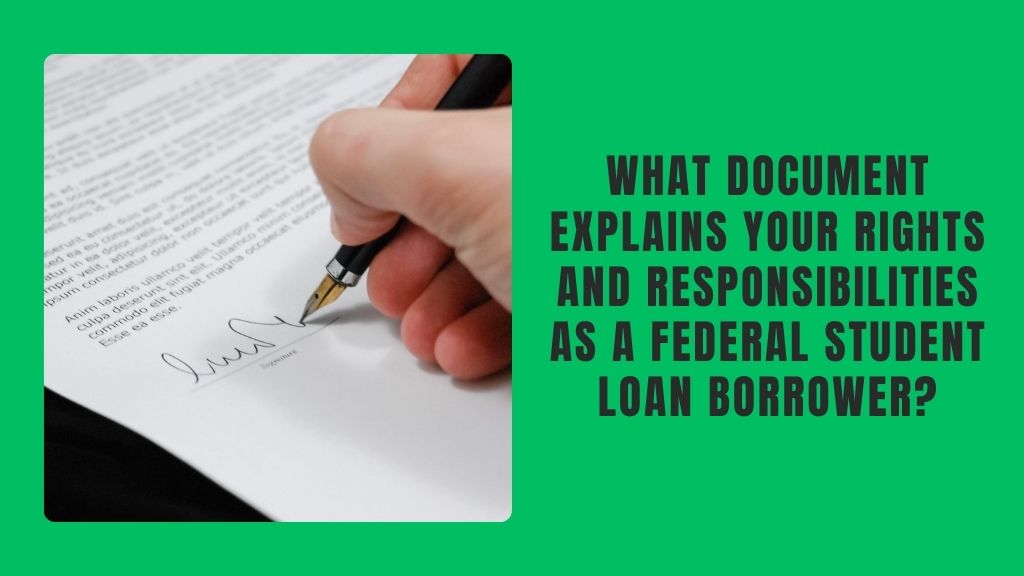When you borrow money to pay for college, it is important to understand your responsibilities and rights as a borrower. Many students take out federal student loans to help cover their education costs, but not everyone reads the documents that come with these loans. So, what document explains your rights and responsibilities as a federal student loan borrower? The answer is simple: the Master Promissory Note (MPN). This document is the key to understanding everything about your loan. It tells you what you agree to when you borrow, how and when to repay the loan, and what your options are if you have trouble.
In this blog, we will explain the MPN in clear and simple language to help you become an informed borrower.
What Is a Federal Student Loan?
Before we talk about the Master Promissory Note, let’s understand what a federal student loan is.
A federal student loan is money borrowed from the U.S. government to help pay for your education. These loans are different from private student loans because they usually have lower interest rates, more repayment options, and protections like loan forgiveness or deferment.
There are four main types of federal student loans:
- Direct Subsidized Loans
- Direct Unsubsidized Loans
- Direct PLUS Loans
- Direct Consolidation Loans
If you borrow any of these, you will need to sign a document before the loan money is given to you—and that document is the Master Promissory Note.
Also read: Who Should You Contact if You Have Trouble Making Payments Once You Leave School?
What Is the Master Promissory Note (MPN)?
The Master Promissory Note (MPN) is a legal document. It is the answer to the question: what document explains your rights and responsibilities as a federal student loan borrower?
When you sign the MPN, you promise to repay your student loan along with any interest and fees. It also explains the terms and conditions of your loan. This includes:
- How much you owe
- The interest rate
- When your payments begin
- What happens if you can’t pay on time
- Your options for deferment, forbearance, or forgiveness
The MPN is used for both undergraduate and graduate students. You may only need to sign it once for multiple loans if they are all from the same loan program.
Why Is the Master Promissory Note Important?
The Master Promissory Note is very important because it protects both you and the government. Here’s why:
A. It Is a Legal Agreement
When you sign the MPN, you agree to follow all the rules. You are making a promise to repay the loan, so it’s not something to take lightly.
B. It Explains Your Rights
The MPN tells you what rights you have as a borrower. This includes the right to:
- Know how much you borrowed
- Receive a payment schedule
- Ask for deferment or forbearance
- Change your repayment plan
C. It Explains Your Responsibilities
The document also explains what you must do, such as:
- Repay the loan on time
- Keep your contact information updated
- Notify your loan servicer if you have trouble paying
- Complete exit counseling when you leave school
Where Can You Find the Master Promissory Note?
You can complete and view your Master Promissory Note online. To do this:
- Go to the official Federal Student Aid website: studentaid.gov.
- Log in using your FSA ID.
- Under “Complete Aid Process,” click on “MPN for Subsidized/Unsubsidized Loans” or the appropriate option.
- Follow the steps to complete or review the document.
Always keep a copy for your records. It’s a good idea to review it from time to time, especially if you are close to graduating.
What’s Inside the Master Promissory Note?
The Master Promissory Note has many important sections. Let’s go through them one by one in simple terms:
A. Borrower Information
This includes your name, address, Social Security number, and school information.
B. Loan Terms and Conditions
This part explains:
- The type of loan you are receiving
- How interest is calculated
- When repayment starts
- Loan limits
- Late fees and penalties
C. Promises and Agreements
This is where you agree to repay the loan and follow all rules. You also give the government permission to collect the money from you if you do not pay.
D. Your Rights and Protections
This includes:
- Getting a copy of your loan records
- Knowing your repayment options
- Asking for help if you face financial problems
- Disputing errors
E. Contact and Communication
You must keep your loan servicer updated with your phone number, address, and employment details. This helps them contact you if needed.
What Happens After You Sign the MPN?
Once you sign the Master Promissory Note:
- The school will receive confirmation.
- Your loan will be processed.
- The money will be sent to your school to pay tuition, fees, and other costs.
You do not need to sign a new MPN each year unless your school requires it or you are taking a different type of loan.
Repayment Responsibilities Explained in the MPN
After you leave school, graduate, or drop below half-time enrollment, your repayment begins. The MPN explains:
A. Grace Period
Most federal loans offer a six-month grace period before you must start making payments.
B. Repayment Plans
You can choose from different repayment plans:
- Standard Repayment (fixed monthly payments)
- Graduated Repayment (lower payments that increase over time)
- Income-Driven Repayment (payments based on your income)
C. Deferment and Forbearance
If you cannot pay for a short time, you may qualify to pause payments through deferment or forbearance.
D. Loan Forgiveness
The MPN also tells you that you may qualify for loan forgiveness, especially if you work in public service, education, or nonprofit organizations.
What If You Don’t Read the MPN?
Some students skip reading the MPN and just sign it quickly. But that can be risky. If you don’t understand what’s in it, you might:
- Miss important deadlines
- Overlook your right to change repayment plans
- End up in default because you didn’t know your options
Reading the MPN helps you stay in control and avoid problems in the future.
Who Can Help You Understand the MPN?
If the MPN seems confusing, don’t worry. There are people and resources that can help you:
- Financial Aid Office: They can explain the loan process and help you read the MPN.
- Loan Servicers: They handle your loan after it is disbursed and can answer any questions.
- Federal Student Aid Website: Offers guides, videos, and tools to help you understand everything about your loan.
- Credit Counselors: Nonprofit credit counseling services can help you make a repayment plan and understand your responsibilities.
Key Tips for Managing Your Loan
Here are some tips to help you stay on top of your student loan after reading your Master Promissory Note:
- Keep a copy of your MPN in a safe place.
- Know your loan servicer’s name and contact information.
- Mark your grace period end date on your calendar.
- Sign up for automatic payments to avoid missing deadlines.
- Review your repayment options early, not just when you have problems.
- Update your contact information regularly.
Final Checklist: Your Rights and Responsibilities
Let’s make a quick checklist of what the Master Promissory Note explains:
✔ Rights:
- You can know the full loan amount and interest rate.
- You can choose or change your repayment plan.
- You can ask for deferment or forbearance.
- You can receive loan forgiveness if you qualify.
- You can dispute charges or errors.
✔ Responsibilities:
- You must repay your loan in full.
- You must inform your loan servicer about changes in your status.
- You must make payments on time.
- You must complete loan exit counseling when required.
Understanding these rights and responsibilities will help you manage your loan better.
Also read: Give Two Reasons Why a 15-year Mortgage is Better Than a 30-year Mortgage.
Conclusion
So, what document explains your rights and responsibilities as a federal student loan borrower? The answer is the Master Promissory Note. It is a powerful and important document that every student loan borrower should read and understand. It protects your rights and reminds you of your duties. By taking time to review the MPN, you can avoid common mistakes and make smart choices about borrowing and repaying your student loan.
Always ask questions if you’re unsure, and use the available tools and resources. Your education is an investment—and understanding your loan helps you protect that investment for a better future.

